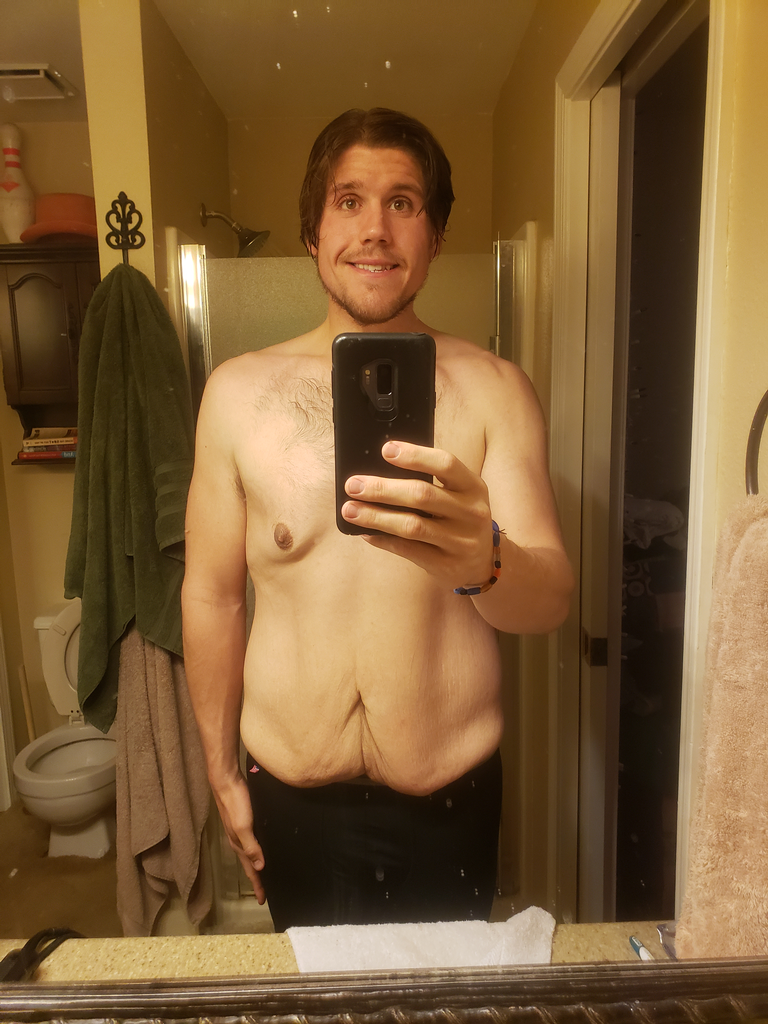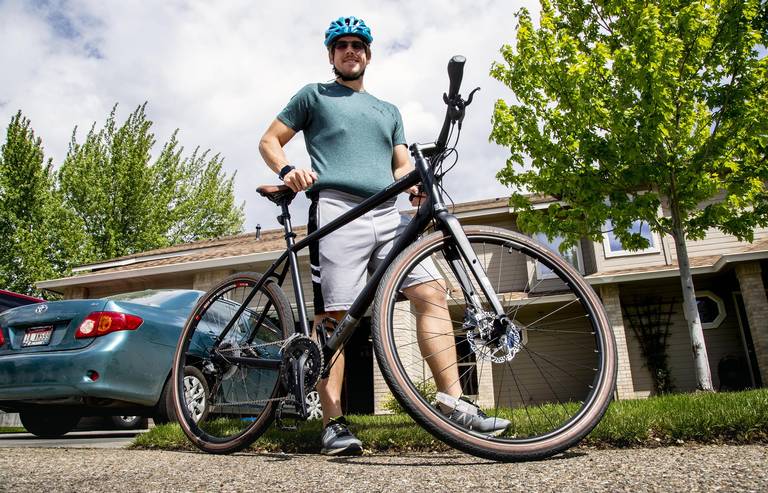He lost 230 pounds, then had to crowdfund $12K to pay for surgery to remove extra skin
Published at | Updated at
BOISE (Idaho Statesman) — Riley Zahm woke up Christmas morning in 2017, and his body was sore. He couldn’t figure out why — he hadn’t done anything out of the ordinary. All he knew was that he weighed 438 pounds. He is an inch or two over six feet tall.
“My body was literally crushing itself while I slept,” he said.
Two months later, he went to a doctor with chest pains. The doctor ran some tests and told Zahm his heart was in good shape — but in about five years, his body would start to shut down unless he made some big changes.
Zahm got the message. Since then, the 31-year-old Boisean has lost about 230 pounds — a whole Riley Zahm’s worth of weight — and kept it off by changing his food and activity habits.
The weight loss was thanks in part to a nutrition and coaching program offered by his employer, Intuit. (Zahm works for the Intuit-owned TSheets.)
Unfortunately, one side effect of drastic weight loss is a bunch of leftover skin. And Zahm’s health insurance plan denied coverage to remove that skin.
Zahm raised more than $12,000 on GoFundMe to pay for a first round of the surgery.
Weight loss through diet, exercise? Not quite
Zahm had tried countless diets. He would last a week or two. Every time, whatever food the diet put off limits became the one thing in the world he wanted to eat. (No carbs? Hello bread cravings.)
The coaching program was different, he says. He was told to change nothing at first, just to keep records. The coaches wanted a baseline for what he ate, his habits, his activity level.
“I went from having no breakfast, no lunch — just huge dinners,” he said in an interview. He would pick up $25 worth of Taco Bell on the way home, play World of Warcraft for a few hours, then eat more fast food.
The coaches encouraged him to try spacing out his meals throughout the day and “throw in some green stuff,” he said. They identified a tendency to eat while he was bored. Instead of trying to stop that habit, they suggested keeping healthier foods around for bored eating, so now he munches on carrots or strawberries.
Making incremental changes in his diet and lifestyle were his path to losing weight and keeping it off. Adding vegetables made his body start to crave them. Going for a run or bike ride gave him endorphins that made him feel good, so he was less tempted to use junk food as an emotional Band-Aid.
Zahm’s coach encouraged him to check in with himself after each lifestyle change. Could he envision keeping up the habit for the rest of his life? Or would he just be setting himself up to fail? For example, Zahm said he doesn’t force himself to avoid certain foods; that’s unsustainable. Instead, he lets himself enjoy things in moderation.

Pounds of skin
Zahm is more active now. He loves to go on 20-mile bike rides between his home in Southeast Boise and Lucky Peak Reservoir.
He also does about 120 ab crunches and 100 pushups a day. But that’s not only for fitness. He was prepared for weight loss to leave behind a lot of stretched-out skin, so Zahm tried to build muscle as he lost pounds of fat.
After losing most of his weight, he went in November to have his body-fat percentage measured. It was 13%. The next time, it was 9% — an athlete’s level.
“I was very surprised to hear (that),” he said. “I realized, that means this is all skin.”
Zahm knew he couldn’t erase the skin with healthy eating or exercise. And it was becoming a problem. He would get what are essentially bed sores between the skin folds. When he worked out, his skin would start to chafe and bleed from the friction.
He went to his primary care doctor and asked for help. The doctor sent him to Dr. John Jarrell, who does plastic and reconstructive surgery in Boise.
‘Punch in the gut’
Not everyone who loses weight needs to have skin-removal surgery.
But some patients have too much excess skin, and it causes medical issues that don’t go away with non-surgical treatment. In those cases, some insurance plans will pay at least some of the costs of surgery, especially if a patient has maintained their new weight for a long time.
Zahm’s surgeon waited until Zahm’s weight had been steady for six months before sending United Healthcare a letter of medical necessity for the procedure, in hopes that it would sway the insurer’s decision in Zahm’s favor.
It didn’t.
Zahm would have to pay out of pocket. The first surgery would cost $8,000.
He was told he could appeal the decision — a process that can be long and complicated with the same eventual outcome for the patient. His friends and family suggested Zahm try sharing his story on GoFundMe.
Zahm later learned that Intuit’s plan had a specific exclusion for the surgery, and the insurance company was following that rule when it denied coverage.
Sarah Hilmer, a spokeswoman for Intuit, told the Statesman that “Intuit offers best-in-class insurance to employees. We assess our programs each year to ensure we remain in the top 25% when compared to peer companies.”
She said that in cases where insurance doesn’t cover a procedure, “we encourage employees to file an appeal with our insurance carrier and, if denied again, they can request an independent medical review by a third party with no alliance to either Inuit or the insurance provider.”
“It is a punch to the gut every time I get out of the shower and look in the mirror and see chafing and sores from simply having extra skin,” Zahm wrote in the description for this GoFundMe campaign, which outraised his $10,000 goal to cover medical bills and time off work for recovery.
The generosity floored him, he said. He didn’t expect that, in a matter of days, people he knew and even strangers would chip in enough that he could afford the surgery.
“Oddly enough, when I talked with the plastic surgeon, I found out that had I not changed my lifestyle and instead opted for bariatric surgery or getting my stomach stapled, insurance would have been more likely to cover this procedure,” Zahm wrote. (The Idaho Statesman was not able to confirm this with Zahm’s surgeon.)

Putting ‘Big Riley’ in the past
The surgery is a milestone in his weight loss, Zahm said. His new weight has held steady for more than six months, and his life is different now. He groans when describing the one downside of surgery: He won’t be able to ride his bike for several weeks.
“Despite making the lifestyle change to be healthy and achieving that goal, I am always reminded of the bad choices I made when I see this hanging extra skin that once was needed for how big I was,” Zahm wrote on GoFundMe.
“While I was able to get to a healthier place, it’s been hard for me to accept that,” he wrote. “And I still need help to finish the journey. I am asking for help to get this surgery so I can finally move past my bad choices. So I can get my head in the right place so I no longer feel like the failure who was Big Riley.”
Zahm checked into Saint Alphonsus for surgery Thursday before sunrise. For a few hours, Jarrell went to work removing excess skin from Zahm’s abdomen. By afternoon, the patient was on his way home to rest, recuperate and get used to life in his new old skin.
This article was originally published in the Idaho Statesman. It is used here with permission.



